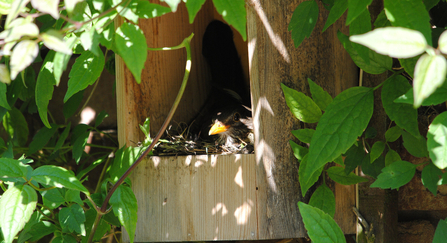The best way to see where birds might be breeding is to spot where they’re singing. If a robin has a favourite song-post in your garden, the nest site won’t be far away. If you’re lucky enough to have a large garden, two or three male (cock) robins may be laying claim to different parts of it, and will defend their boundaries with posturing and sometimes fighting. Great tits and blue tits are house-hunting, visiting nest boxes and suitable holes in trees and buildings before returning with nesting material. Sometimes squabbles take place over a particularly desirable residence – maybe both a great tit pair and a brace (group) of house sparrows have their eye on the same site. It’s all fascinating to watch, and really gives you the feeling that spring is truly here.
Dr Cath's Nature Notes - April 2023
(c) Bob Coyle
Gillian Day
There are times when our feathered neighbours decide to set up home in what is, to us, an inconvenient place. Robins seem to be particularly good at it. A shelf in the shed or garage suits them very well – ours raised two broods amongst the plant food and lawn mower spares right next to our garage door, and a neighbour had a rather noisy nest-full behind the paperbacks on their bedroom bookshelf. Another has an annual crop of great tits from their postbox. It might be difficult to avoid disturbing nesting birds in these situations, but shown a bit of respect, they seem to cope with human presence. If someone starts to build a nest somewhere really impossible, ask them politely to leave as early in the building as you can – they’ll find another site nearby. It’s usually possible to reach an accommodation though, and enjoy these really close encounters.

Blackbird in a nest box (c) Amy Lewis
For other, more considerate birds nesting in the garden, the most important thing to remember is ‘Do Not Disturb’! It might be tempting to take a quick peek to see how they’re getting on or to show the children the eggs or babies, but try to resist. Particularly when the bird is sitting on eggs, any sort of disturbance can provoke them to abandon the nest, and can also draw the attention of predators such as cats or magpies.
How else can you help the breeding birds in your garden?
Keep putting out high quality bird food. For male birds, the physical demand of maintaining the territory, with all the singing and patrolling involved needs a constant and easily-obtained input of calories. For females, the bodily stress of producing eggs is draining, and a quick meal at the feeder reduces time spent away from the unguarded nest hunting for food. In many species, the female (hen) does the majority or all the brooding. Foods such as sunflower hearts and fat blocks or suet pellets provide a high calorie nutritious boost. Try to make sure food is available first thing in the morning and late afternoon, as nights may still be cold.
Offering a breeding-season extra of fine shell grit is a good idea, as the production of viable eggs depends on an adequate supply of calcium. In nature, this is usually obtained from snail shells or the exoskeletons of insects such as woodlice, but not having suitable sources can lead to thin, porous eggshells. Another easily available calcium supplement is smashed-up eggshell from your breakfast egg, so why waste it! Eggs are usually formed overnight, so put out the calcium supplements in the afternoon. Clean water should also be made available at all times.
If you’re blessed with nesting swallows or house martins, it can be difficult for these mud-builders to find wet mud in a dry spring. I’ve had success helping them by putting out a tray of mud and keeping it wet. An old dustbin lid served nicely, but a large plant tray or similar would work well.
And finally, here’s a really interesting thing – starlings pick aromatic flowers to add to their nests! They don’t do it for interior design, but to fumigate the nest of smells and keep pests away. So if you see marauding starlings pinching your blooms, don’t get cross – they’re not bandits, they’re aromatherapists. Watch out for other species trying it too – I’d love to know how common it is.
Enjoy your April garden and the new explosion of life it brings!



